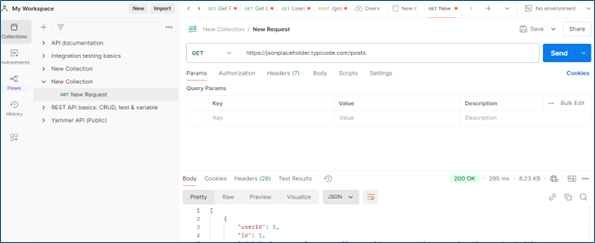Postman software is one of the most popular tools for API testing and development. It’s user-friendly, feature-rich and widely used by developers, testers and anyone working with APIs. Whether you’re testing the functionality of an API, automating workflows or generating API documentation, Postman has got you covered. In this guide, we’ll explore how to get started with Postman, uncover its powerful features and learn how to leverage it for advanced API testing and development tasks, complete with real-life examples.
Getting Started With Postman Software
To begin, visit the official Postman download page and download the version suitable for your operating system. The installation is straightforward, and within minutes, you’ll have Postman up and running on your machine.
When you open Postman for the first time, you’ll notice several key components:
- Workspaces: Create personal or team workspaces to organize your work.
- Collections: Group related API requests together.
- Environment Variables: Manage different settings for development, staging and production environments.
Real-Life Example:
You’ve joined a new development team tasked with testing a payment gateway API. Your manager asks you to set up Postman on your laptop so you can immediately start testing. Following the steps in this section ensures you’re ready to dive in.
Your First API Request
Let’s say you want to fetch data about the latest posts from a public API. Here’s how to do it:
- Open Postman and click on “+ New Tab.”
- Enter the URL: https://jsonplaceholder.typicode.com/posts
- Select the HTTP method (GET by default).
- Click “Send.”
- View the response in the bottom pane.

Real-Life Example:
Imagine you’re building a news aggregator app that fetches trending articles. Using this API, you test how your app retrieves and displays articles, ensuring the app layout matches the received data. Congratulations! You’ve just made your first API request using Postman.
Exploring Features
Collections and Folders:
Organize your API requests logically. For example:
- Group all endpoints for user management (e.g., login, registration, profile update) in one collection.
- Create another collection for order management, such as creating, updating and deleting orders.
Real-Life Example:
You’re developing an online shopping website. You organize endpoints into collections, such as “User Authentication” for login and registration and “Product Management” for CRUD operations. This structure keeps your workflow efficient and organized.
Environment Variables:
Environment variables let you switch between setups seamlessly. For instance:
- Use variables for base URLs, such as {{base_url}}, and API keys.
- Set environments for development (dev.api.shop.com) and production (api.shop.com).
Real-Life Example:
Your team handles multiple client projects. For one client, their development environment uses dev.clientapi.com, while their production environment uses prod.clientapi.com. By setting environment variables in Postman, you switch seamlessly between environments without manually altering every endpoint, minimizing human error.
Pre-request and Test Scripts:
Postman lets you use simple JavaScript scripts to enhance your API testing:
- Pre-request scripts: These run before the request is sent. For example, they can automatically add a token to the request for secure APIs.
- Test scripts: These run after receiving the response to check if it meets your expectations, like confirming an order ID is included after placing an order.
Real-Life Example:
Imagine you’re working on a banking app. Every API request needs a token for authentication.
- A pre-request script in Postman can automatically add this token to your requests.
- A test script can check if the response includes user details after a successful login.
Advanced Features of Postman Software
Mock Servers
Imagine your front-end team is designing a weather app, but the backend isn’t ready yet. You can:
- Create a mock server in Postman.
- Define a response for an endpoint, such as GET /weather, to return mock weather data.
- Share this with your front-end team so they can continue development.
Real-Life Example:
Your front-end team is creating a weather dashboard for a travel website, but the backend is delayed. You create a mock server to simulate responses for endpoints like /current-weather or /forecast. This enables the UI team to integrate and test designs without waiting for backend readiness.
API Documentation
Generate professional-grade API documentation directly from your collections. Share this with:
- Internal teams for clarity.
- External clients to integrate your API into their systems.
Real-Life Example:
You’re developing an API for a ticket booking system. After building endpoints for booking, cancellation and seat selection, you generate and share detailed API documentation with third-party developers, enabling them to integrate seamlessly with your service.
Practical Applications
Testing a Public API
Let’s test the OpenWeather API:
- Sign up for a free API key from OpenWeather.
- Create a GET request in Postman with this URL:
https://api.openweathermap.org/data/2.5/weather?q=London&appid={{api_key}} - Replace {{api_key}} with your actual key and click “Send.”
- Inspect the response for weather details.
Real-Life Example:
You’re building a weather-based reminder app. Using the OpenWeather API, you test endpoints for fetching weather data. After ensuring accuracy, you proceed to integrate the feature, where the app reminds users to carry an umbrella on rainy days.
Building an Automated API Test Suite
- Add endpoints like /charge, /refund, and /transaction to a collection.
- Write test scripts for each to validate responses.
- Use the Collection Runner to execute tests with varying inputs, such as different currencies or amounts.
Real-Life Example:
You’re tasked with maintaining a payment gateway. To ensure consistent performance, automate test cases to validate functionality for various amounts and currencies. This helps you catch potential issues early and improve user satisfaction.
Debugging Common API Issues
Postman is excellent for resolving issues like:
- Authentication Errors: Verify headers and tokens.
- Timeouts: Check API response time and improve server configurations.
Real-Life Example:
You’re troubleshooting login failures in a food delivery app. After inspecting the API in Postman, you discover an expired authentication token is causing the issue. Updating the token resolves the login errors and restores service.
Tips and Tricks
- Use keyboard shortcuts (e.g., Ctrl+S to save, Ctrl+K to search).
- Explore plugins and integrations, such as GitHub and Slack.
- Familiarize yourself with OAuth and API key configurations for secure access.
Real-Life Example:
You’re managing APIs for a live event ticketing platform. By integrating Postman with Slack, you receive real-time notifications for failed API requests, helping you address critical issues before they escalate.
Takeaways
Postman software is an indispensable tool for anyone working with APIs. Its versatility and ease of use make it a must-have for developers, testers and API enthusiasts. By mastering Postman, you’ll streamline workflows, enhance collaboration and ensure your APIs are reliable.
Author: Swati Raj | [email protected]
Contact Us
Not sure where to start? Get in touch with Withum’s experts to see what’s possible.



